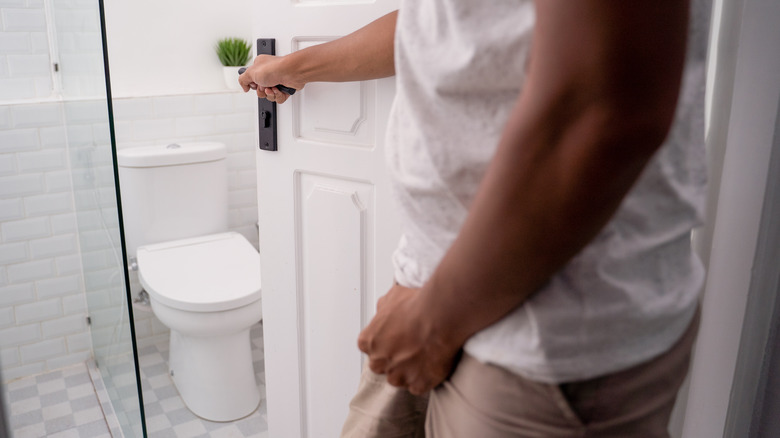The Serious Belly Button Warning Sign That Could Spell Trouble For A Man's Health
Aches and pains are part and parcel of life. A grueling workout could leave muscle aches that last for a few days. Getting out of bed the wrong way one morning may leave a neck sprain that is refusing to go away. While some such physical signs can be traced back to relatively harmless things you did to bring them on, others are indicative of something more serious.
Lasting pain between a man's belly button and thigh area, also known as your pelvic region, for example, is a health symptom men should never ignore. It could be a warning sign that you're dealing with prostatitis, an enlarged prostate (also known as benign prostate hyperplasia), hernia, or some type of cancer. Other reasons for pelvic pain include urinary tract infections (UTIs), sexually transmitted infections (STIs), irritable bowel syndrome (IBS), appendicitis, cystitis, urinary stones, urethral strictures, pudendal nerve entrapment, and chronic pelvic pain syndrome. Let's take a look at them, one by one.
UTIs, STIs, hernias, and kidney stones: How do they cause pelvic pain?
A UTI, which can affect your urethra, kidneys, and bladder, can result in pelvic pain. Pressure in the lower part of your pelvis and penis pain are also symptoms of a UTI. Cystitis, which is a type of UTI that affects your bladder, results in pelvic pain as well. Other warning signs of a UTI include a persistent urge to urinate, frequent peeing, painful urination, cloudy urine, bloody pee, fever, chills, and nausea.
STIs like chlamydia and gonorrhea can affect your pelvic organs and cause discomfort in the area. While it's possible to have an STI and not have any signs, some of the symptoms associated with STIs are discharge in your penis or anus, painful urination, lumps in your genital region, rashes, itchy genitals, and blisters in the area.
With hernias, an underlying health condition or tissue weakness results in an organ that pushes through the tissue, typically in your abdomen or groin area. Depending on where the hernia is located, you could experience pain in your belly button region. You might also be able to notice a bulge in the pubic bone region, pressure in your groin area, and even pain and swelling around your testicles. With urinary stones, the pain in your pelvic area could be related to the stones moving from your kidney to your urinary tract. Pain in your lower back, bloody, smelly, and cloudy urine, fever and chills, and nausea are other warning signs.
Belly button pain that's related to prostatitis
Prostatitis is an inflammation of your prostate, the walnut-shaped gland that sits close to your urethra, rectum, and bladder. While experts think that any number of things can lead to this kind of pelvic pain, the main cause seems to be a bacterial infection of your prostate that leads to inflammation, swelling, and corresponding pain. Men can develop prostatitis because of a bladder infection, an STI, and other reasons. An enlarged prostate or BPH is thought to occur with age, and related changes to testosterone levels and cells in your testicles. When your prostate gland grows in size, this can affect urinary function while also contributing to pelvic pain.
IBS is a disorder of the gastrointestinal tract that manifests in symptoms like abdominal cramps, bloating, gas, weight loss, changes in bowel movements, and chronic pelvic pain. An infected or blocked appendix (appendicitis) can result in discomfort in the belly button region, too. A few things can cause your urethra to become narrow (also known as a urethral stricture), like injury, inflammation, or infection. Pain while peeing, pelvic pain, and a swollen penis are symptoms of urethral strictures.
Pudendal nerve entrapment, aka pudendal neuralgia, is an injured, irritated, or compressed pudendal nerve (the nerve that runs from your pelvis to your genital area) that results in chronic pelvic pain. Chronic pelvic pain syndrome (pain that lasts longer than six months) could be caused by underlying health conditions like prostatitis, IBS, hernia, or muscle, joint, and bone-related problems.
Cancer and pelvic pain, explained
For men, cancer symptoms can often go ignored. Some experts seem to think that this could be related to the nature of the symptoms themselves: they're either vague or non-existent until they reach an advanced stage.
Testicular, prostate, or colon cancer can cause pain in the belly button region. With testicular cancer, this means that the cancer has spread to the pelvic lymph nodes. The same can be said for colon, rectal, and prostate cancer. With testicular cancer, there's also another hidden sign men shouldn't ignore: a swelling in your testicles. Prostate cancer can manifest in urinary, erectile, ejaculatory, and lower extremity-related symptoms like frequent urination (especially at night), painful urination, bloody urine, weak urine, bloody semen, difficulty achieving an erection, painful ejaculation, and lower back pain. Swelling can be a sign of prostate cancer, too. Colon cancer warning signs include rectal bleeding, bloody poop, diarrhea, constipation, and unexplained weight loss.
Whatever the reason, knowing about pelvic pain and what it could be related to can help you get yourself checked in time and treat whatever underlying condition is causing the discomfort. In the case of cancer, it could even mean early detection and a better chance at combating the disease. If you're at risk because of a family history of the disease or simply want to be careful, get screened. There is an age at which you should be screening for prostate cancer, for example.



